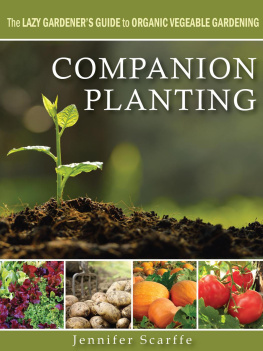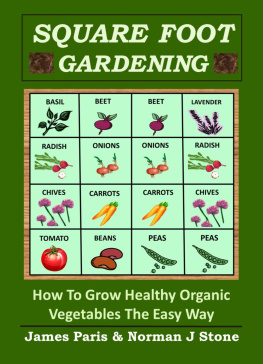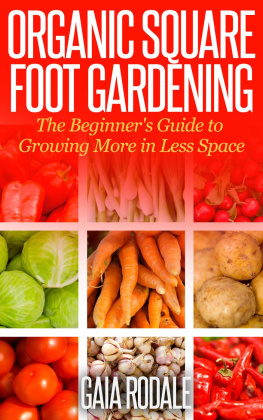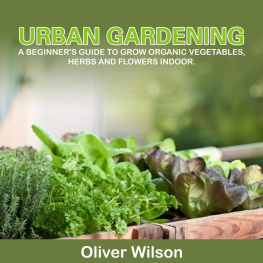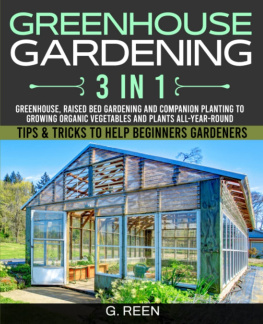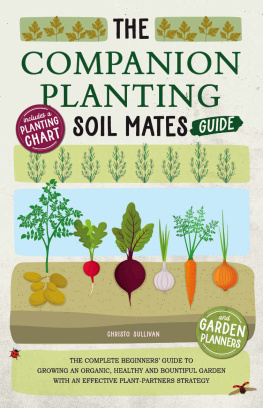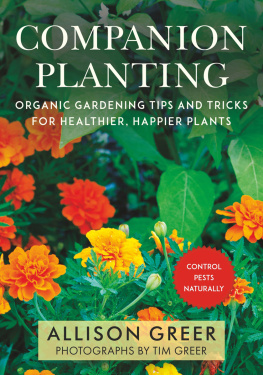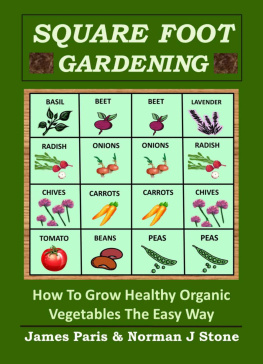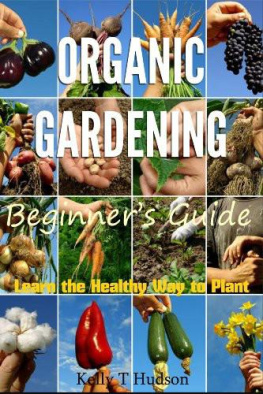Beginners Guide To Companion Planting
Gardening methods using plant partners to grow organic vegetables
Peter Shepperd
Copyright Wryting Ltd 2021 - All rights reserved.
The content contained within this book may not be reproduced, duplicated or transmitted without direct written permission from the author or the publisher.
Under no circumstances will any blame or legal responsibility be held against the publisher, or author, for any damages, reparation, or monetary loss due to the information contained within this book, either directly or indirectly.
Legal Notice:
This book is copyright protected. It is only for personal use. You cannot amend, distribute, sell, use, quote or paraphrase any part, or the content within this book, without the consent of the author or publisher.
Disclaimer Notice:
Please note the information contained within this document is for educational and entertainment purposes only. All effort has been executed to present accurate, up to date, reliable, complete information. No warranties of any kind are declared or implied. Readers acknowledge that the author is not engaged in the rendering of legal, financial, medical or professional advice. The content within this book has been derived from various sources. Please consult a licensed professional before attempting any techniques outlined in this book.
By reading this document, the reader agrees that under no circumstances is the author responsible for any losses, direct or indirect, that are incurred as a result of the use of the information contained within this document, including, but not limited to, errors, omissions, or inaccuracies.
Contents
This checklist includes:
10 items you will need to kick off your green fingered adventure.
The highest quality Gardening items.
Where you can buy these items for the lowest price.
The last thing we want is for your gardening project start to be delayed because you werent prepared.
To receive your essential tool checklist, visit the link:
www.petershepperd.com/gardening-checklist
Introduction
A garden requires patient labour and attention. Plants do not grow merely to satisfy ambitions or to fulfil good intentions. They thrive because someone expended effort on them.
- Liberty Hyde Bailey
Most of us have grown up in a world that is dominated by intensive monoculture farming. Fields of maize, wheat, rice and barley not only dominate the landscapes of many states and countries, but also influence the way in which we have become accustomed to eating. Despite a dramatic increase in the range of vegetables and fruit on offer, we mainly survive on a small portion of those. It is true that we may have treats that sometimes fall outside of the traditional mainstay crops, but our diets are still dominated by those products that can be grown on a large-scale, commercial basiswheat, rice and maize.
This eating to suit commercial production has widespread ramifications that nobody could have foreseen. As vast areas of land are dedicated to just one or two crops, soils become denuded of nutrients and the need for chemical fertilisers cannot be avoided. That, in turn, brings environmental repercussions, many of which are proving to be catastrophic. Closer to home, our more limited diets are depriving us of the vitamins and nutrients that we once consumed simply through eating so many different types of planta boon for the supplement manufacturers, but not so good for us.
This book is going to take a different approach to gardening. Instead of narrowing the selection of plants we eat, I aim to broaden that range dramatically and to do so using methods that were once common knowledge. Just like humans, plants thrive best in communities. The method of combining plants that bring benefits to one another is called companion planting. There is nothing new about it and, as you will see, in many parts of the world, it has been practiced for millennia.
Companion planting brings with it a multitude of different benefits, but they are all tied together by one underlying theme: the desire to harness nature, rather than trying to whip her into submission. Surely, the use of chemical fertilisers and pesticides has now gone on for long enough? We have seen disaster after disaster, watched the demise of bird and insect populations and stood by as vast swathes of our oceans are turned into dead zones. Now is the time to change that and to try to reverse some of the damage we have done to the planet.
This book does not offer a roadmap to doing this on a large scale. It does, however, offer you the possibility of doing what you can on a small scale, as an individual. You are not going to change the entire world by growing your own produce in harmony with nature, but you might change your own world. If enough people were to do the same, then the collective impact could be huge. The objective here is not just to increase the productivity of your vegetable garden, but to transform it into a mini ecosphere, where nature does much of the heavy lifting in terms of pest control and re-introduction of nutrients. We want it to be a place where life of many different types thrives, and not just a monocultural desert, devoid of all life, except for one or two crops.
I don't come at this subject waving a professorship in plant science or multiple degrees in horticulture. Instead, I want to share with you what more than a decade of organic gardening has taught me through trial and error. This is never going to be a subject that makes me into a multi-millionaire, but it is one about which I am passionate, and that combination of hands-on experience and deep passion must count for something.
I won't be delving too deeply into heavy science here. There are others far better qualified than I am to do that. Instead, I will take you on a journey that I have been on for many years. It is speckled with pitfalls and disasters that sometimes occur when you work with nature, but when you harvest your first warm tomato or pull that first succulent, homegrown carrot from the earth, those problems are quickly forgotten. I hope this book will teach you all about the subject of companion planting and its many benefits and at the same time, that it will help you to avoid some of the errors that I made on my own journey. Above all, I hope that it will inspire you and that you will come away as passionate about organic gardening as I am. If that happens, you will never look at the food on your plate in quite the same way again.
Companion planting is a broad subject and, as is often the case when delving into a new field, it can seem a little overwhelming. Right from the start, I want to point out that this can be something you introduce to your gardening gradually. You can try a combination or two here and there and then, if you are happy with the results, build on it the following year. Little by little, both your knowledge and your skills will start to increase. You will also experience a dramatic growth in self-confidence when it comes to gardening. Feel free to use this information in bite-sized chunks, rather than treating it as one gastronomic meal.
Who's the Right Companion For Your Plant?
C ompanion planting can be carried out for one of several reasons. Some plants act as a deterrent for pests, while others might be grown to attract beneficial insects. Some plants provide food or accommodation to pollinators, while others bind nutrients into the soil and therefore increase yields. We might also use companion planting simply because it makes more sense to plant one plant alongside another, purely to save space. Like so much to do with nature, the subject is interlinked and woven together in its own intricate ecosystem, and it is the gardener's job to find the best way to harness those interplant connections.




